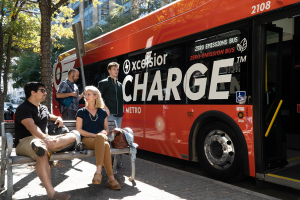As electric trucks and buses charge ahead, how can we help them avoid roadblocks?
 The business and environmental case for electrifying large electric vehicles – such as buses, delivery trucks, garbage trucks and regional “day cab” tractors used at ports – is gaining traction, and there’s good reason to be excited about this momentum.
The business and environmental case for electrifying large electric vehicles – such as buses, delivery trucks, garbage trucks and regional “day cab” tractors used at ports – is gaining traction, and there’s good reason to be excited about this momentum.
FedEx recently announced that it’s adding 1,000 EV delivery vans to its fleet. Amazon announced a $700 million investment in an electric truck start-up and then pledged to have half of its deliveries be zero-emissions by 2030. And in California, all new municipal buses will be zero-emissions within a decade, the result of a bold new program adopted by the state’s Air Resources Board last year.
As companies and local governments move from piloting electric fleets to full deployment, their climate potential is becoming clearer. For example, a recent Bloomberg report found that by the end of 2019, a cumulative 270,000 barrels a day of diesel demand will have been displaced by electric buses globally. That’s more than three times the displacement by all the world’s passenger electric vehicles.
But there is still much more to be done, and no time to wait. Diesel emissions from trucks and buses can increase cancer risk, neurological and metabolic diseases, and cause respiratory and cardiovascular damage. What’s worse, low-income communities and communities of color are host to a disproportionate share of these toxic air pollutants.
These vehicles are also a major source of climate pollution, and are on pace to nearly double in the next 30 years. Already, we are seeing their effect on our climate ambitions. Diesel use from trucks was a leading factor in why U.S. greenhouse gas emissions were up in 2018 after falling for several years.
As electric trucks and buses charge ahead, how can we help them avoid roadblocks? Share on XIt’s clear we must accelerate the introduction and adoption of large electric vehicles today. To do this, we’ll have to tackle two key challenges.
Roadblocks to electrification
Integrating the charging demand from electric trucks and buses into the grid is a major hurdle. Most large electric vehicles are likely to have a use pattern where they return to the same facility each night. This means that fleet depots could have significant spikes in electricity demand as vehicles charge. For example, a fleet of 50 buses charged simultaneously could draw upwards of three megawatts of power, which is comparable to the electricity demand of a major skyscraper.
We can address this challenge through grid modernization efforts that enable more clean, efficient charging. For example, putting in place commercial fleet rate structures that encourage charging during off-peak times when clean energy is abundant, making investments to upgrade grid capacity in strategic locations and leveraging “smart charging” software to prioritize charging among vehicles.
A second key challenge is balancing the significant lifetime cost savings electric vehicles promise with their upfront costs. The continued decline in battery costs – already down 85 percent from 2010 – will lessen this challenge significantly over the coming years. A recent analysis by the California Air Resources Board found that battery electric trucks will be cost competitive with a wide range of diesel trucks by 2024. In the interim, we need to pursue a variety of financing and grant solutions that will accelerate adoption of these vehicles to deliver their significant air quality benefits today.
All hands on deck
Many different stakeholders need to actively engage to accelerate the success of large electric vehicles.
- Utilities need to ready the grid, update rate structures and continue to transition to renewable energy.
- Vehicle manufacturers need to dramatically increase and diversify their production of large electric vehicles.
- Companies with fleets need to enthusiastically pilot these vehicles and develop aggressive plans to transition the bulk of their large vehicles to zero-emission vehicles.
- Policymakers – at federal, state and local levels – need to advance programs that drive these crucial, cost-effective solutions into our fleets.
- Advocates, including Environmental Defense Fund, need to identify solutions to the barriers holding back large electric vehicles, while also demanding companies and agencies embrace ambitious targets for the adoption of large electric vehicles in their fleets and in the fleets of their supply chain partners.
There is a lot to gain by working together. These vehicles promise improved air quality for overburdened communities, lower lifecycle costs, reduced greenhouse gas emissions and a more resilient, reliable electric grid. As UPS president of global fleet maintenance recently explained, “With the proper design and vision, the shift to electrification won’t be incremental, it could be transformational.”










